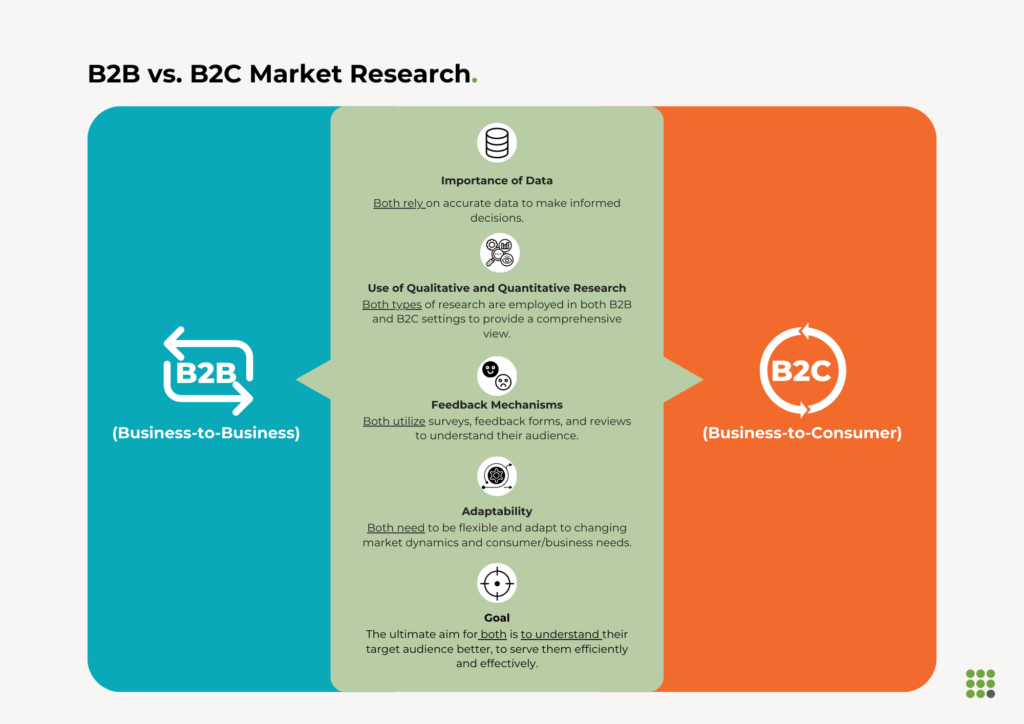Making the right decisions in business is critical. For companies in the B2B sector, these choices can shape their future success or failure. So, how can businesses ensure they’re making the best decisions? The answer is clear: B2B market research.
Market research isn’t just about collecting data. It’s about understanding the market, knowing your competitors, and determining what your customers really want. It’s a tool that provides clarity in a complex business environment.
Every decision a company makes – from launching a new product to entering a new market – should be backed by solid research. It’s like having a roadmap in unfamiliar territory. As we dive into the importance of B2B market research, remember this: in a world full of information, understanding that information is what sets successful companies apart.
The Evolving Landscape of B2B Markets
The B2B market isn’t what it used to be. Like everything in the business world, it’s changing and evolving rapidly. A few years ago, businesses had the luxury of time. They could test the waters, make a decision, and then adapt based on the results. But those days are long gone.
Now, the market moves at lightning speed. New competitors are entering the scene almost daily, and they’re not just local businesses. Thanks to technology, even a tiny startup from halfway around the world can be a threat. This surge in competition means that companies can’t afford to rest on their laurels. They must be proactive, always on their toes, ready to adapt and innovate.
So, how do businesses keep up? The answer is data-driven strategies. In the past, many decisions were based on gut feelings or past experiences. While experience is valuable, it’s not enough in today’s dynamic market. Companies need hard facts, clear insights, and actionable data. This is where B2B market research comes into play. By understanding the market’s shifts and trends, businesses can make informed decisions that give them an edge over their competitors.
In short, the B2B market is more competitive and challenging than ever before. But with the right tools, like comprehensive market research, businesses can navigate these challenges and thrive.
What is B2B Market Research?
B2B market research is a systematic process that businesses use to gather, analyze, and interpret data about their target market, competitors, and the industry as a whole. While the core essence of market research remains consistent across different sectors, there are key differences when comparing B2B (Business-to-Business) and B2C (Business-to-Consumer) research.


As shown in the table above, B2B market research primarily focuses on businesses that are selling to other businesses. This means the considerations, challenges, and strategies will differ from those of B2C market research.
For instance, B2B market research often deals with longer sales cycles. Decisions in the B2B realm aren’t made on a whim; they often involve multiple stakeholders and can span weeks or even months. This contrasts with B2C, where individual consumers might make a purchase decision in minutes based on an emotional connection or a compelling advertisement.
Relationship-building is also more emphasised in B2B. Businesses are not just looking for a one-time sale; they’re aiming for long-term partnerships, which means understanding and catering to the specific needs and pain points of other businesses.
Another significant difference lies in the audience. B2B market research targets a smaller, more specific audience, often characterised by particular industry niches or specialised roles within companies. This is in stark contrast to B2C, where the audience is broader, encompassing a wide range of consumers with diverse preferences and behaviours.
Lastly, B2B market research requires a deeper understanding of industry jargon, complexities, and nuances. It’s not just about knowing what businesses want but understanding the intricacies of their operations, challenges, and industry trends.
While B2B and B2C market research aims to provide valuable business insights, the method, focus, and outcomes can vary considerably. Recognising these differences is crucial for any company looking to gain a competitive edge in their respective markets.
Types of B2B Market Research
In B2B market research, different methodologies cater to distinct objectives and needs. Broadly, these methods can be categorised into three primary types: Quantitative Research, Qualitative Research, and Secondary Research. Let’s dive deeper into each category to understand their nuances and applications.
1. Quantitative Research
At its core, quantitative research seeks to quantify data and typically applies statistical analysis. This type of research is instrumental when businesses want to measure and analyze trends, patterns, or relationships within a market.
- Surveys: One of the most common tools in the quantitative research arsenal, surveys can be distributed widely to gather responses from a large sample size. These responses, often in the form of standardised closed-ended questions, provide a numerical representation of market opinions or behaviours.
- Structured Interviews: Unlike casual conversations, structured interviews involve a pre-defined set of questions asked in a specific order. They combine the rigour of surveys with the personal touch of interviews, ensuring consistent data collection across participants.
2. Qualitative Research
Qualitative research, on the other hand, delves into the ‘why’ and ‘how’ behind data. It’s more exploratory in nature and aims to provide insights into market motivations, reasons, and underlying opinions.
- In-depth Interviews: In-depth Interviews (IDI)are one-on-one conversations between a researcher and a respondent. The goal is to explore detailed perspectives, experiences, and motivations. Such interviews are flexible and can be adapted based on the respondent’s answers.
- Focus Groups: Focus groups bring together a small group of participants to discuss a specific topic or set of topics. Guided by a moderator, these discussions can reveal shared experiences, common pain points, and collective insights that might not emerge in individual interviews.
3. Secondary Research
While quantitative and qualitative research involve primary data collection, secondary research leverages existing data. It involves analysing information that has already been gathered, either internally by the company or externally by other organisations.
- Industry Reports: These are comprehensive documents that provide insights into a specific industry’s current state, trends, challenges, and opportunities. They’re invaluable for businesses looking to understand their market landscape.
- Publications: Articles, journals, whitepapers, and other published materials can offer a wealth of knowledge. They can provide historical context, expert opinions, and detailed analyses that can be instrumental in shaping a company’s strategies.
B2B market research isn’t a one-size-fits-all endeavour. Depending on the objectives, businesses can employ a mix of these research types to gain a holistic view of their market, make informed decisions, and chart a path to success.
From Insights to Action: The Process
The journey from raw data to actionable insights is a structured and meticulous process. At its heart, it’s about translating information into meaningful strategies that drive business growth. Let’s walk through the critical stages of this transformative journey.
1. Data Collection
Before making any informed decisions, businesses need a wealth of relevant data at their disposal. The key is to gather comprehensive and accurate data that truly reflects the market landscape.
- Identify Objectives: Begin by pinpointing what you aim to achieve. Whether it’s understanding customer behaviour, gauging market demand, or assessing competitor strengths, having clear objectives will guide the data collection process.
- Choose the Right Tools: Depending on the research type (quantitative, qualitative, or secondary), employ appropriate tools. This could range from surveys and interviews to analyzing industry reports.
- Diverse Sources: Don’t rely on a single source. Collate data from multiple channels to ensure a well-rounded perspective. This could include customer feedback, online reviews, sales data, and more.
2. Data Analysis
Once you have a robust dataset, the next step is to sift through this information to derive meaningful insights.
- Data Cleaning: Start by filtering out any irrelevant or erroneous data points. This ensures that the analysis is based on accurate and pertinent information.
- Pattern Recognition: Use statistical tools and software to identify trends, correlations, and patterns within the data. For instance, is there a specific feature that most B2B customers value? Or a common pain point they face?
- Deep Dives: Don’t just skim the surface. Dive deep into the data to uncover underlying reasons, motivations, and triggers. This will provide a richer context and more nuanced insights.
3. Strategy Formation
With insights in hand, it’s time to translate them into actionable strategies.
- Align with Business Goals: Ensure that the derived strategies align with the company’s broader objectives. Whether expanding into a new market segment, refining product features, or optimising pricing, the strategy should serve the larger business goals.
- Stakeholder Collaboration: Involve various departments and stakeholders in the strategy formation. A collaborative approach ensures the strategies are practical, feasible, and holistic.
- Continuous Iteration: The market landscape is dynamic. As such, strategies should be flexible and adaptable. Regularly revisit and refine them based on new data and changing market conditions.
In essence, the journey from insights to action is a systematic one, rooted in rigorous data collection, thoughtful analysis, and strategic planning. By adhering to this process, businesses can not only understand their market better but also carve out a distinct competitive edge.
How StellarTech Navigated Market Challenges with B2B Market Research
In the competitive world of enterprise software solutions, StellarTech, a fictional company, found itself at a crossroads. Despite having a robust product suite and a loyal client base, they witnessed stagnating sales and increased competition from emerging players. The company knew they had to pivot, but the direction was unclear.
The Challenge:
StellarTech’s primary product, an enterprise resource planning (ERP) software, was once a market leader. However, with the advent of cloud computing and niche software solutions, their offering seemed outdated. The company needed to decide whether to invest in a complete product overhaul, diversify its software suite, or explore untapped markets.
The B2B Market Research Approach:
StellarTech embarked on a comprehensive market research journey. They initiated a mix of quantitative and qualitative research methodologies:
- Surveys and Structured Interviews: Targeting their current client base, they aimed to understand the strengths and weaknesses of their existing product and what additional features or improvements were desired.
- Focus Groups: Bringing together IT heads from various industries, StellarTech sought to grasp the evolving needs of businesses and where their software could fit in.
- Industry Reports and Publications: A deep dive into secondary research provided insights into market trends, emerging technologies, and competitor offerings.
The Insights:
The research revealed a clear demand for cloud integration capabilities and industry-specific software solutions. Moreover, there was a significant market in small to mid-sized businesses that found current ERP solutions either too complex or too expensive.
The Strategy:
Armed with these insights, StellarTech decided on a three-pronged approach:
- Product Enhancement: They initiated the development of a cloud-integrated version of their ERP software, ensuring flexibility and scalability.
- Diversification: Recognising the demand for industry-specific solutions, they began developing modules tailored for sectors like healthcare, manufacturing, and retail.
- Market Expansion: StellarTech launched a scaled-down, cost-effective version of its software targeting small to mid-sized businesses, filling a significant market gap.
The Outcome:
Within a year of implementing these strategies, StellarTech saw increased sales and successfully expanded its client base. Their tailored solutions became a hit in industries where they previously had a minimal presence.
This fictional tale of StellarTech underscores the transformative power of B2B market research. When approached methodically and acted upon strategically, market insights can pave the way for business rejuvenation and growth.
Navigating the Hurdles
B2B market research is a powerful tool, but like any tool, it has challenges. Understanding these challenges and proactively addressing them is crucial for any business aiming to harness the full potential of its research efforts.
1. Biased Data:
Challenge: One of the most common pitfalls in market research is data bias. This can stem from various sources – from leading questions in surveys to a non-representative sample group.
Solution: Ensure questionnaires are neutral and free from leading or loaded questions. It’s also essential to diversify the sample base, including various industries, company sizes, and demographics. Regularly review and update research methodologies to minimise bias.
2. Changing Market Dynamics:
Challenge: The business landscape is ever-evolving. What’s relevant today might be obsolete tomorrow. Relying on outdated data can lead to misguided strategies.
Solution: Adopt a continuous research approach. Instead of one-off research projects, regularly update your data, keeping an eye on industry trends, technological advancements, and shifting customer preferences. Utilise real-time data analytics tools to stay updated.
3. Over-reliance on Quantitative Data:
Challenge: While numbers and statistics provide a clear overview, they often miss the nuances and qualitative aspects of the market.
Solution: Balance quantitative research with qualitative methods. In-depth interviews, focus groups, and open-ended surveys can provide context, depth, and a more holistic understanding of the market.
4. Information Overload:
Challenge: In the age of big data, businesses often find themselves drowning in a sea of information, struggling to determine what’s relevant.
Solution: Prioritise data based on business objectives. Use data visualisation tools and dashboards to sift through vast amounts of data, highlighting critical insights. Regularly review and declutter datasets, ensuring only pertinent information is retained.
5. Limited Internal Expertise:
Challenge: Not every company has in-house market research experts, which can lead to poorly designed research methodologies or misinterpretation of data.
Solution: Consider partnering with specialised market research agencies. They bring expertise, experience, and advanced tools to the table, ensuring research is comprehensive and insights are accurately derived.
6. Cultural and Regional Differences:
Challenge: For businesses operating globally, understanding cultural nuances and regional preferences is vital. Standard research methodologies might not be applicable across all regions.
Solution: Localise research efforts. Collaborate with local experts or agencies who understand the cultural and regional dynamics. Ensure research tools, like surveys, are translated and culturally adapted.
While B2B market research presents its set of challenges, they’re not insurmountable. By recognising these potential obstacles and implementing best practices, businesses can ensure their research efforts are robust, relevant, and actionable.
The Horizon Ahead: The Future of B2B Market Research
The realm of B2B market research, like many industries, is poised for significant evolution in the coming years. Driven by technological advancements, changing business landscapes, and an ever-increasing demand for data-driven insights, the future holds exciting prospects. Let’s delve into some predictions and trends shaping the next chapter of B2B market research.
1. Integration of Artificial Intelligence (AI):
Forecast: AI will become a mainstay in market research processes. From data collection to analysis, AI-powered tools will offer deeper insights, faster results, and enhanced accuracy.
According to a report by the MIT Sloan Management Review, over 85% of companies believe AI will offer a competitive advantage in the future, with a significant portion of this advantage stemming from insights and analytics.
2. Real-time Data Analysis:
Forecast: The demand for real-time insights will grow exponentially. Businesses will no longer be content with periodic research reports but will seek continuous, up-to-the-minute data to make agile decisions.
A study by PwC revealed that 67% of business leaders believe real-time data analysis will be crucial to their operations within the next few years.
3. Predictive and Prescriptive Analytics:
Forecast: Beyond understanding current market dynamics, businesses will lean heavily on predictive analytics to forecast future trends. Furthermore, prescriptive analytics will guide businesses on the best course of action based on these predictions.
4. Increased Focus on Data Privacy:
Forecast: With regulations like GDPR and CCPA in place, the emphasis on data privacy will intensify. Market research methodologies will need to be adapted to ensure compliance while still gleaning valuable insights.
According to Cisco’s Annual Cybersecurity Report, 84% of businesses feel that data privacy is a competitive differentiator in today’s market.
5. Virtual Reality (VR) and Augmented Reality (AR) in Research:
Forecast: VR and AR will offer immersive research experiences. For instance, virtual focus groups or product testing in augmented reality environments will provide richer, more nuanced feedback.
6. Growth of DIY Research Tools:
Forecast: While specialised research agencies will always have their place, the proliferation of DIY research tools will empower businesses to conduct preliminary research in-house, leading to more informed and collaborative engagements with research agencies.
7. Natural Language Processing (NLP) in Sentiment Analysis:
Forecast: NLP will revolutionise qualitative research, especially in sentiment analysis. Analysing customer feedback, reviews, and open-ended survey responses will become more precise, capturing the subtleties of human emotion and intent.
The future of B2B market research is not just about more data but better, more actionable insights. As technology continues to shape this domain, businesses equipped with the right tools and methodologies will find themselves at the forefront, making informed decisions that drive growth and innovation.
In the Vanguard of Business Success: The Imperative of Market Research
In an era where information is abundant, but actionable insight is rare, the distinction between enterprises that thrive and those that merely survive lies in their approach to market research. Businesses, especially in the B2B domain, are not navigating calm waters but are braving a storm of rapid change, fierce competition, and shifting customer expectations.
Market research, in this context, is not just a tool—it’s a compass. It provides direction amid ambiguity and offers clarity in the face of complexity. B2B enterprises that relegate market research to the sidelines do so at their peril. For it’s not merely about understanding the market; it’s about shaping it, leading it, and setting the gold standard for others to follow.
To dismiss or undervalue market research is to disregard the very lifeblood of strategic decision-making. Ultimately, the enterprises that will stand tall recognise the profound power of informed insight and, more importantly, act on it. In the unfolding chapters of the business story, let market research be the ink with which success stories are written.
Get regular insights
Keep up to date with the latest insights from our research as well as all our company news in our free monthly newsletter.





 Senior Marketing Executive
Senior Marketing Executive Sales & Marketing
Sales & Marketing General Manager PR -Internal Communications & Government Affairs
General Manager PR -Internal Communications & Government Affairs Vital Strategies
Vital Strategies
 Customer Intelligence Director
Customer Intelligence Director